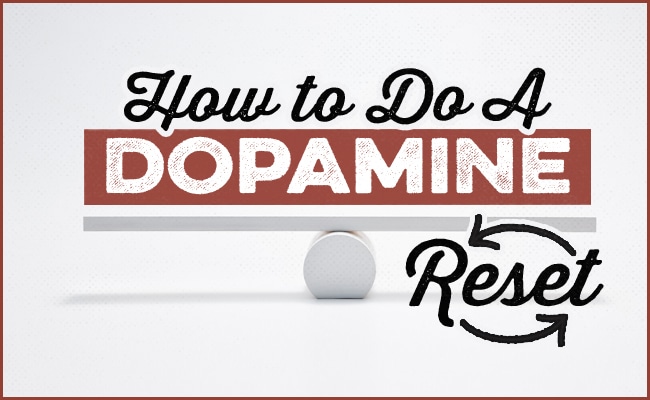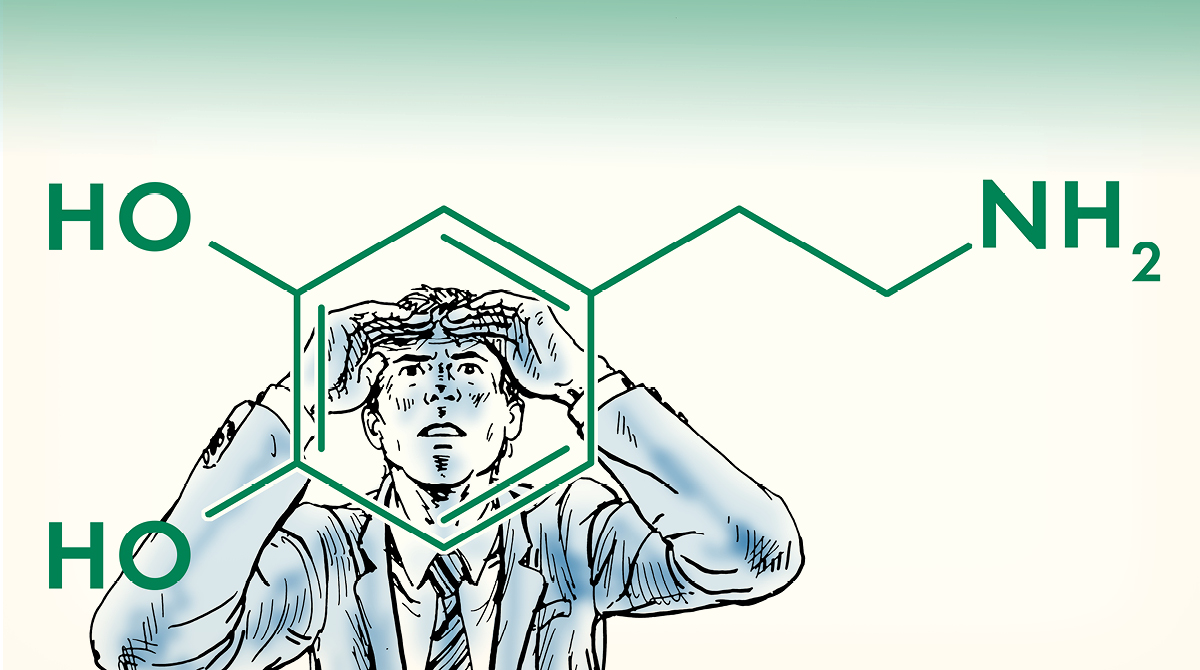
Has life been feeling flat?
Do you not get the same pleasure from activities you once enjoyed?
Is it feeling harder to get motivated to do things?
Are you unhappy with a habit like constantly checking your smartphone or watching porn?
Do you want to kick an addiction to alcohol or tobacco?
If you answered yes to any of these questions, you might consider doing a dopamine reset.
The Pleasure/Pain Balance
Dopamine is the neurotransmitter of wanting. It’s what makes pursuing goals so dang pleasurable. Dopamine is released in our brains whenever we encounter rewards, or “natural reinforcers,” that help us survive and thrive. Food, sex, novelty, friendship, praise, and money are all natural reinforcers. Whenever we encounter them, dopamine is released, which helps create a neurological pathway in our brains so that we repeat the same behaviors that helped us attain the rewards previously.
Usually, the dopamine released by natural reinforcers is adaptive. It’s good to want food, sex, and novelty in moderation. These things contribute to our mental and physical well-being. But sometimes, adaptive dopamine-driven behaviors can become maladaptive. Binge eating, obsessive porn watching, and all-consuming video game playing are examples of healthy impulses being hijacked into unhealthy compulsions.
Drugs and other substances release dopamine in even greater amounts than things like food and sex. This is what makes drugs addictive despite them being so bad for you. The dopamine spike created by certain substances causes addicts to repeat the abuse behaviors so that they can repeat the high.
The interesting thing about dopamine is that besides inducing the pleasure of desire, it also causes us to experience pain.
As psychiatrist Dr. Anna Lembke explains in her book Dopamine Nation, our bodies and minds like to keep things in homeostasis. Lembke highlights research that whenever the brain experiences a big, pleasurable spike in dopamine, it downregulates dopamine transmission and its sensitivity to dopamine to bring things back into balance. But the thing is, our brain doesn’t stop this downregulation when things get back to even. It will keep downregulating until the balance is tipped an equal and opposite amount to the side of pain.
This dynamic, called the opponent process mechanism, explains why you feel pretty let down after achieving a big goal. You had a lot of dopamine driving you to achieve it, but once you reached the goal, your brain downregulates your dopamine, so much so that you feel bummed.
This is why high-performance athletes and artists often battle post-victory depression after notching a big achievement.
It’s the same thing with something like masturbation; you feel driven to do it, but after achieving the reward of orgasm, you can feel kind of deflated and even dejected.
The opponent process mechanism also explains why drug addicts feel really bad after the initial high. The significant, drug-induced spike towards the pleasure side of the balance is followed by an equal and opposite dip into pain.
To counter the pain that comes after a dopamine spike, the addict will consume more and more of the drug or engage in more and more of the maladaptive behavior (e.g., compulsively watching porn or gambling.) They’re trying to get their pleasure/pain balance to shift back into pleasure.
Unfortunately, this only makes an individual’s pleasure response get weaker and shorter thanks to tolerance, while the pain side of the balance dips even further down. The addict ends up in a state of dopamine deficit. When they’re in this dopamine deficit, they don’t really enjoy anything. Things that once gave them pleasure no longer do. They feel a lack of motivation and happiness and sink into depression. Psychologists call this state anhedonia.
Even if you’re not addicted to drugs or gambling, Lembke argues that we can all experience this dopamine deficit if we engage in dopaminergic activities too much. Maybe you’ve experienced the existential flatness of anhedonia thanks to checking your smartphone excessively. Not only does perusing TikTok no longer give you any pleasure, but as you check it more and more, hoping to get a dopamine hit from some novel story, it increasingly puts you into a dopamine deficit that saps some enjoyment from other activities in your life as well.
So how do you get out of this dopamine deficit and back to your dopamine baseline so that you feel motivated and driven, but in a healthy way?
By doing a dopamine reset.
How to Do a Dopamine Reset
We all have different dopamine baselines. Some of us are more dopaminergic and naturally seek greater novelty and excitement. Others are less dopaminergic and feel more at home eating corn flakes every morning and listening to the same music they did in college. Wherever you fall on that spectrum, a dopamine reset will get you out of your dopamine deficit and back to your healthy dopamine baseline.
When Dr. Lembke treats patients with addictions, she walks them through the following steps for doing a dopamine reset. The goal is to help her patients get their dopamine pleasure/pain balance out of pain and back to its natural homeostasis. She wants her patients not to hurt anymore and kick the addiction.
You might benefit from a dopamine reset even if you don’t have a severe addiction. If you’ve been feeling a little flat lately, you might be experiencing a bit of dopamine-induced anhedonia. A dopamine reset can also help you break bad habits like constantly checking your smartphone.
Note: If you’re still feeling flat and unmotivated after doing this reset, you might consider visiting a psychologist to explore whether the problem isn’t just your dopamine balance and may be a case of clinical depression.
Do a Dopamine Fast
As mentioned above, whenever we get into a dopamine deficit, our natural tendency is to try to feel better by doing more of the drug or behavior that got us our initial dopamine spike. But that only deepens the dopamine deficit.
Lembke argues we’d be better off abstaining from the drug or behavior. When we do that, our brains naturally take us out of the dopamine deficit and back to baseline.
One of the first things Lembke recommends her addiction patients do is take a dopamine fast for a month. That means abstaining from the problematic substance or behavior for four weeks. She admits that this is really hard to do, especially in those first two weeks, but the payoff is worth the effort. It really does get you back to baseline.
A dopamine fast will take some willpower, but Lembke recommends utilizing various behavioral techniques to bolster your self-control, like putting barriers between you and your maladaptive habit. That could mean removing all the drugs and booze in your house or placing internet filters on your computer and smartphone.
For individuals who don’t have full-on addictions, Lembke suggests that a fast that lasts a day or week is likely enough to get you back to your dopamine baseline. If checking your phone too much is a problem, consider incorporating a weekly tech sabbath into your life; if you’re not happy with your snacking, fast entirely from food for a day.
After you complete your dopamine fast, you can decide whether or not to reintroduce the behavior you were abstaining from, depending on whether you think it added something to your life and whether you can use it/do it in moderation.
Press on the Pain to Get More Pleasure
If you’d like to turbocharge your dopamine fast to help you get out of a dopamine deficit, Lembke recommends enhancing its pain.
Don’t worry. You won’t have to whip yourself or wear a hairshirt.
It seems counterintuitive: when your pleasure/pain balance is already tipped toward the pain side, you can restore balance by pressing on the pain. But remember the opponent process mechanism we discussed above: our brain likes homeostasis, and if it notices we’re engaging in activities that add weight to the pain side of our pleasure/pain balance, it will respond by shifting things to the pleasure side.
And according to Lembke, the pleasure we receive from mildly painful activities gives us access to dopamine via an indirect source that makes it less vulnerable to the problem of tolerance, dependence, and withdrawal.
So how can we press on the pain side a bit more to turbocharge our dopamine fast?
Cold Water Exposure. We’ve been advocates of cold showers since before they were cool. Lembke has found that cold showers and ice baths are a great way to press on the pain, tap into a healthy source of dopamine, and restore your dopamine baseline.
Cold water is very unpleasant and causes you to gasp and shiver. Despite the pain, research has shown that 1-3 minutes of cold water exposure can increase dopamine concentrations by 250%. What’s interesting about the dopamine surge from cold showers and baths is that it’s gradual and goes back down gradually. This might explain why the dopamine we get from taking them doesn’t cause the same problems as the sudden dopamine spikes from drugs or other maladaptive behaviors.
Exercise. Like cold showers, exercise can be unpleasant. You get out of breath and sweaty. Your muscles and lungs burn and ache as you strain to lift heavy weights or perform an all-out sprint.
But this pain is highly effective in bringing your dopamine system back to baseline.
Research highlighted by podcast guest Dr. Jennifer Heisz shows that recovering drug addicts do better when they combine their recovery with exercise. Lembke has observed the same thing in her work.
Drug abuse releases supernatural amounts of dopamine that strip away the brain’s receptors for it. Natural stimuli, which release far less dopamine, lose their ability to feel sufficiently rewarding. This only makes drugs more addicting, as the addict becomes reliant on them as their sole source of pleasure.
Exercise speeds up the process by which the brain’s dopamine receptors return to their normal state; once they’ve recovered, an addict is in a much better place to kick their habit because they can once again experience a “high” from natural things and are no longer dependent on the substance for pleasure.
Plus, exercise itself gives the brain the reward its dopamine seeks, which helps crush cravings.
Other Hard Activities. Lembke also recommends that patients press on the pain side of the pleasure/pain balance by engaging in hard activities beyond cold showers and exercise. This could be reading a challenging book, fasting from food, or working on a difficult household project. Anything that frustrates you can help you press on the pain side of things and restore your dopamine to baseline levels.
In conclusion, while dopamine is a master pleasure hormone, it can work against us when our pleasure/pain balance swings too far into the pleasure side. Fortunately, by engaging in a dopamine reset, we can return to a healthy neural balance.
For more insights on the role of dopamine in your life, listen to our podcast with Dr. Anna Lembke:







